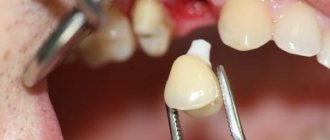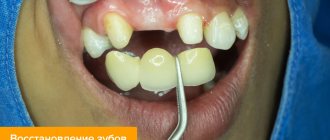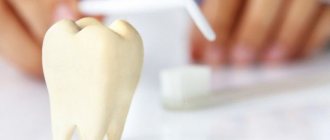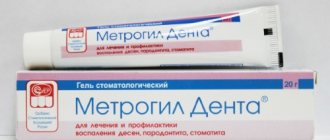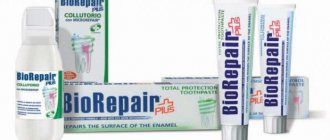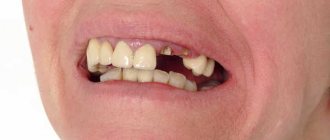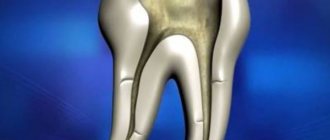20951
During their life, almost everyone has at least once encountered the problem of dental damage.
In most cases, we simply do not notice this - upon closer examination, you can see that there are multiple chips and scratches on the enamel.
In fact, these are all phenomena of the same order with more significant injuries - fractures and so on. We will tell you in more detail what should be done when such a problem is detected, as well as what the causes of “breakdowns” are.
Why do teeth chip off?
Enamel is one of the hardest tissues of the human body. It consists of:
- inorganic substances (about 96%);
- water (about 3%);
- organic substances (1%): enamelins, amelogenins.
The thickness of the enamel can reach 2.5 mm, regardless of the patient’s gender. This tissue does not contain collagen and is therefore incapable of regeneration. With age and with a lack of vitamins, it becomes thinner, as a result of which even an ordinary apple can cause tooth enamel to chip.
Chips on teeth appear for several main reasons. If the dentist can identify the cause of the defect, treatment will be effective, otherwise further dental problems may occur. Standard reasons why pieces of teeth fall off include:
- mechanical damage due to injury, falling, biting too hard foods (nuts, caramel);
- weakened enamel;
- hormonal imbalance;
- demineralization of dental tissues – enamel and dentin;
- low acidity in the mouth;
- damaged filling;
- abnormal bite: deep, gnathic, crossbite;
- presence of dental diseases: pulpitis, caries, periodontal disease;
- weak immune system.
If the doctor correctly diagnoses the cause of a chipped tooth, he will not only be able to correct the existing defect, but also prevent the further formation of dental pathologies.
What to do if part of a tooth breaks off?
Visit a dental clinic as soon as possible after your injury. To completely restore damaged tissue and prevent the situation from getting worse, you need to act quickly. If a similar misfortune happens to a person nearby, he may need first aid.
First aid
In case of chipped teeth, specialized medical care is required, but in the first minutes after the injury, you can take a number of measures on your own. Rinse your mouth with warm water (use boiled water) to remove pieces of food and enamel particles. If the gum is damaged and bleeding occurs, apply a sterile bandage to the wound. To reduce pain and swelling, you can cool the tissues surrounding the injured area with ice or a cloth soaked in cold water. If pain causes significant discomfort, take an analgesic (a group of non-steroidal anti-inflammatory drugs).
Therapy at the dental center
To restore the healthy appearance of teeth, dentists use various restoration methods. If there is a minor chip of the enamel, composite materials are used that harden when exposed to light. From the same materials, the doctor creates a dental inlay, which is then attached to the surface of the tooth with glue if the dentin is damaged due to chipping.
Dental inlays are microprostheses, so their creation requires a pre-made impression. But in some clinics it is possible to make a composite inlay in less than a day. Thanks to this, the time spent on treatment is significantly reduced, and the patient stops experiencing pain much faster. This is especially important if there is an injury to the front teeth, and it is also necessary to restore the aesthetic appearance of the dentition.
Veneers are special microprostheses made of various materials (most often ceramics) that help quickly and efficiently correct chipped front teeth on their outer side. Minor chips of the molars are corrected with fillings, and sharp edges of the chip line are smoothed by grinding.
If the pulp is injured, the doctor performs an intervention called depulpation. It helps avoid inflammation and relieves pain. In such a situation, the tooth is restored using a pin. This device reduces the pressure exerted on the injured tooth and prevents its further destruction.
Chipped molars
The method of restoration of molars for chipped teeth is chosen by the dentist individually and depends on the location and degree of injury. Chips on the inside of molars are eliminated by installing fillings, and on the outside, damage is restored using composite materials. It is very convenient to correct damaged lateral teeth by installing metal-ceramic crowns. This material is very durable and can withstand significant loads when chewing food.
Chipped front teeth
If a front tooth is chipped, patients also suffer from psychological discomfort. If the frontal part of the dentition is affected, people may experience difficulty smiling and talking with others, and over time, speech distortions and facial expression disturbances may occur. Therefore, if a tooth is chipped, it is very important to visit the dentist on time.
If the enamel and dentin are damaged when a front tooth is chipped, a filling is installed and the sharp edges of the chip line are polished. When the pulp chamber is injured, the doctor performs depulpation and then fills the tooth (sometimes installing a pin). In some clinical situations, the use of microprostheses (veneers and lumineers) or composite dental inlays is required.
Enamel chip
Enamel is one of the hardest tissues of our body, but despite this, it requires constant and careful care. It is important to monitor its safety and remember the factors that contribute to its destruction. Cracks in enamel can occur due to excess consumption of carbohydrates, excessive consumption of solid foods, poor personal hygiene and bad habits. If after the formation of a chip or crack the dentin is not damaged, people are in no hurry to see a dentist due to the almost complete absence of symptoms. Minimal discomfort in the oral cavity is also a reason to visit a doctor, this way you can avoid many negative consequences and prevent the destruction of dental tissues.
Dentin chip
Dentin is the part of dental tissue located under the enamel that protects the nerve and pulp chamber. In terms of hardness, it is somewhat inferior to enamel. If a tooth is moderately chipped, destruction of dentin is possible, which is why the pathological process penetrates into the pulp chamber. When dentin is damaged during a tooth chip, the sensitivity of the damaged tooth sharply increases (hyperesthesia) when consuming hot, cold, sour, etc.
Chip exposing the pulp
If the pulp chamber is damaged, sharp pain occurs, which is poorly relieved with painkillers. It is recommended to visit a dentist as soon as possible. The doctor removes the pulp, cleans all the canals, removes the nerve, and then begins to restore the injured tooth. We invite you to visit our dentistry! We provide dental services near the Krasnye Vorota, Baumanskaya, Tretyakovskaya metro stations, as well as Novokuznetsk.
Symptoms and diagnosis
“Victims” will quickly find out about the appearance of a chip on the front tooth. This defect is clearly visible, so it is easily detected even in the absence of pain. It is more difficult to notice damage to the rear molar: part of the enamel or filling can be broken off and accidentally swallowed along with food, and microcracks are not at all visible to the naked eye, so a person should focus not only on the visual characteristics of the dentition, but also on the sensations during conversation and eating .
If a person has lost part of a tooth, he can find out about it by the following symptoms:
- increased sensitivity to cold or hot;
- pain on palpation;
- slight swelling.
The first place in diagnosing the cause of a chip is occupied by a simple visual inspection. The dentist collects anamnesis, clarifies the circumstances under which the defect occurred, and examines the problem area. In most cases, the cause is identified immediately, so additional diagnostics are only rarely required.
If it is difficult for the dentist to determine the cause of the chip during a routine visual examination, he will have to resort to additional diagnostic methods:
- radiovisiography;
- CT scan;
- dental camera images (allow you to find the deepest caries);
- study of tissues in a dental microscope;
- examination of the pulp with an Apex Locator;
- laboratory tests blood tests.
Symptoms
Of course, it is not always possible to identify a split tooth yourself; this damage is detected with maximum accuracy during examination by a doctor. But this type of damage may be accompanied by some symptoms, which should be paid special attention to.
Such a crack can lead to the entry of bacteria into the tooth cavity, inflammation of the root canals, the development of pulpitis, as well as further tooth loss.
When a tooth splits, the following symptoms may occur:
- Painful sensations, they can be observed in different parts;
- There is an increased degree of tooth sensitivity. They may react to temperature changes when eating cold and hot food, and long-term aching discomfort appears;
- Chewing and biting causes pain.
If the above symptoms occur, you should immediately consult a doctor for the necessary treatment. Sometimes the damage may be located inside the tooth, which cannot be determined visually. If a tooth with a crack is not treated for a long period, then various pathological processes will appear in it, which lead to additional symptoms:
- Changing the color of tooth enamel. This symptom occurs due to the presence of necrotic processes in the area of the pulp chamber;
- The occurrence of an unpleasant odor from the oral cavity;
- The damaged tooth seems to grow out of the jaw, and when you touch it, strong and sharp pain appears;
- The gum area surrounding the damaged tooth becomes inflamed and very red;
- With severe complications, the formation of pathological pockets of the periodontal type occurs.
First aid at home
If a person’s tooth falls off, the list of actions that he can perform at home will depend on the nature of the defect. If a person does not feel pain or severe discomfort, then he can simply make an appointment with his dentist or come to an appointment with the doctor on duty. If, due to a chip, a tooth hurts, bleeding occurs, and the gums become inflamed, then before visiting the dentist you can:
- relieve pain with painkillers: Ketanov, Nurofen, Ibuklin, Analgin;
- rinse your mouth with herbal infusion or a solution of soda and salt;
- carefully close the chipped area (with cotton wool or chewing gum);
- apply a gauze or cotton swab to stop the bleeding;
- if it gets worse, but there is no way to call an ambulance right now or go to a dental clinic, take an anti-inflammatory drug.
What to do before going to the dentist
If you have a chip, you should visit your dentist as soon as possible. At home, in order to avoid the development of unpleasant consequences, a number of measures should be taken to help reduce pain.
Many people believe that restoring a chipped tooth is an expensive procedure, but delaying a visit to the dentist only makes the situation worse. The following video will tell us why an immediate medical examination is so important:
First aid includes:
- rinsing the mouth with lukewarm water or a weak salt solution up to three times a day (the procedure will help remove blood, dirt, and food debris);
- brushing your teeth daily and rinsing them between meals (this should be done more carefully at the site of damage);
- applying a cold compress to reduce gum swelling;
- saving a piece of tooth (if the chip is quite significant);
- disinfection of scratches and cuts in the oral mucosa to avoid infection.
To prevent toothache, you should take painkillers. The following will also help reduce pain:
- Novocaine: a tampon soaked in it is applied to the affected area;
- attached propolis;
- validol: a quarter of the tablet is placed into the affected tooth.
If the tooth is also very loose, the root may be additionally broken. The first thing you need to do is fix it: gently but firmly squeeze your jaws. Then apply an ice compress on top of it.
Unfortunately, you can’t do anything else on your own. All other actions to treat and restore enamel are taken only by a doctor!
Methods for restoring and treating chipped tooth enamel
Some patients are afraid to go to the dentist because they think that he will immediately remove the broken tooth. But the first thing a dentist will do with a tooth that has chipped is to try to save it (with the exception of wisdom teeth).
If the dental root is not inflamed, then the dentist will not remove a molar just because it is chipped. But the longer the patient delays visiting the doctor, the more likely the tooth becomes infected with caries and loses it.
Classic treatment
Treatment for a chipped tooth depends on the nature of the damage. The following methods are distinguished:
- Extension using composite materials. Suitable for microcracks and minor chips in the front teeth. The material is applied directly to the damaged, previously prepared area of enamel. The procedure allows you to restore a tooth in one dental visit.
- Restoring the shape of a tooth with dental inlays. This method is used if half a tooth has broken off and chewing function is impaired. It consists of installing bulk fillings on the injured area and is used only for the treatment of chewing teeth.
- Installation of veneers and lumineers imitating tooth enamel. The method is effective for minor dental damage on the front teeth and consists of gluing thin onlays to the prepared “front” part of the tooth.
- Installation of crowns necessary if the tooth is severely damaged (half of the crown or only the roots remain). During the procedure, the pulp is resected, the cavity is ground and cleaned, after which it is filled and a crown is installed.
- Implantation. This method is used if a tooth has to be removed. Its essence lies in the fact that a dental prosthesis is implanted into the jaw bone tissue, replacing the tooth root, and a crown is installed on it.
Simultaneously with the treatment of the chip, it is recommended to correct the patient’s bite in order to minimize the risk of further development of the pathology.
Enamel restoration
If the damage is detected at an early stage and affects only the surface layer of the tooth - the enamel, then you can try to restore it. There are two main methods of enamel restoration:
- remineralization;
- fluoridation.
Remineralization
When using this method of tooth restoration, its upper dental layer is treated with special preparations with microelements. The problematic molar is covered with a special protective film and is not destroyed under the influence of external factors.
Fluoridation
In this case, the tooth surface is coated with preparations containing fluoride. The procedure can be carried out at home, after consulting with a doctor. This method is not used for serious dental pathologies.
Innovative restoration technologies
If a patient's tooth has broken off, the doctor may suggest that the defect be eliminated with the help of:
- fiberglass, which has excellent characteristics and imitates natural tooth enamel as naturally as possible;
- Glasspan technology, which consists of restoring the front teeth using a ceramic ligament;
- functional and cosmetic restoration of chipped areas.
Methods for restoring tooth integrity
Even if you receive a minor injury and there is no severe pain, the chip should be shown to a dentist, who will give recommendations and offer the necessary treatment option. What the dentist will do if a tooth chips directly depends on the nature of the damage and location.
If a small piece of a front tooth has fallen off, you can try to restore it using artistic restoration using composite materials. This is the most economical and effective treatment option (estimated price - from 4 to 10 thousand rubles). The specialist selects the color of the paste, applies it in layers, building up the missing piece.
Each stage of composite application is secured with light radiation. In case of significant damage and when extension is impossible, veneer coating is used. The doctor applies it from the base of the tooth, completely repeating the lost shape. This is a very strong and durable material that does not lose its color. Typically, a crown is required when a large piece has chipped or crumbled.
To treat a chewing tooth, the same methods are often used (with the exception of veneering). Since chewing molars are not visible to others, it will be enough to eliminate the violation with a filling. The missing piece will be built up using a light-hardening filling.
If a baby tooth is damaged, even if it is only slightly chipped, parents should first disinfect the child’s oral cavity and then go to the doctor. He will treat the chip site with a prophylactic gel and prescribe treatment. In most cases, a conventional filling is used, which helps strengthen the bone tissue until the baby teeth fall out and the molars erupt.
Restoring chipped wisdom teeth makes little sense because they are not involved in the chewing process. Most often they are simply removed.
If a tooth chips during pregnancy, a woman should consult a doctor as soon as possible. You can undergo treatment without complications for the fetus from the beginning of the second trimester. The use of halogen lamps and hogs does not harm the body of the expectant mother. When the chip is insignificant, restoration can be carried out without using anesthesia. In case of large damage, it is necessary to warn the dentist about pregnancy. He will select a drug that does not contain adrenaline. Dental tissues that are not treated before the birth of the child can cause dysbiosis in the newborn.
The treatment method for molars depends on the degree of injury and its location. In case of damage, fillings are installed on the inner wall, and composite materials are used on the outer wall.
Minor damage to the chewing surface is usually filled. The use of core inlays with crowns restores integrity violations that make up more than half of the area, especially on chewing molars.
Situations often occur when half a tooth breaks off, and the remaining part inside becomes black. The diagnosis is made after undergoing X-ray diagnostics and most often the tooth is removed. In the best case, only its roots are preserved, the canals are cleaned and sealed. Only then is it possible to install the crown on the pin.
Chips during pregnancy: why and what to do
If, as a result of hormonal changes and calcium leaching, a piece of a tooth breaks off in a pregnant woman, she should immediately consult a dentist. You can undergo dental treatment from the 12th week of pregnancy , so if a woman has a chipped part of her tooth, she has no reason to hesitate and endanger herself and the child.
Any crack in the enamel can cause the development of caries, pulpitis and other dental diseases, which in the future will have to be treated with the use of strong anesthetics and antibiotics. Therefore, it is better to restore the chipped area of the tooth immediately after it is damaged.
Halogen lamps and burs are not harmful to the body of a pregnant woman. If a small piece breaks off from a tooth, you can treat it without anesthesia, otherwise you will need to inform your doctor about your pregnancy so that he can select an anesthetic drug without adrenaline. If a chipped tooth is not treated before the baby is born, the newborn baby may develop dysbacteriosis or another disease associated with caries.
Enamel chipping - causes, classification and modern restoration methods
Chips on enamel are one of the most common injuries, the result of mechanical stress. This could be a bruise, a blow, a fall, or, for example, carelessness while chewing solid food. But in other cases, damage occurs as a result of the thinning and weakening of the top protective layer on the teeth - in such a situation, even a minor impact can cause the enamel to break off from the tooth. Read further in this article about what else can provoke such a problem and how to remove such a defect.
Chipped baby teeth
In young children, baby (and sometimes molar) teeth often break off. Most often, this is caused by impacts or falls on the floor. If the child is injured, you should calm him down and then go to the dental clinic. The baby tooth will be cured or permanently removed depending on the severity of the pathology. The chip cannot be left unattended.
Even a small crack in the enamel can cause inflammation in the oral cavity. It may be associated with sore throats and frequent acute respiratory viral infections. Due to chipping, there is a risk of developing pathologies of the digestive and respiratory systems. Advanced caries, which appears on baby teeth due to chips and cracks, can lead to problems with molars and malocclusion.
Why might a tooth crack?
Poor nutrition causes tooth enamel to weaken. Often the problem is faced by people who neglect foods high in calcium and fluoride. If the enamel is weak, any factors can lead to cracks. So, some people have bad habits of cracking nuts or opening bottles with their teeth. Common household trauma can also contribute to the appearance of a crack. Dental problems are often found among athletes (boxers, wrestlers).
If a tooth cracks in a dream, it is possible that the patient suffers from bruxism. This is grinding your teeth in your sleep. The patient may have a hereditary predisposition to bruxism. Also, the disease often develops against the background of stress or overwork. Grinding leads to increased wear of hard tooth tissues. The enamel is damaged and cracks appear. Therapy is carried out not only by a dentist, but also by a psychologist. Sometimes the patient is prescribed hypnosis sessions.
Broken tooth under crown
Signs of a chipped or broken tooth under a crown:
- the crown with the stump or half of it broke off;
- the crown wobbles at the slightest mechanical impact;
- the tooth under the crown began to hurt;
- gums are swollen.
If only a piece of a tooth breaks off, it can be saved. But you will definitely have to throw away the old crown, because:
- the crown has been damaged since the break;
- During dental treatment, additional procedures will be required that will change the physical characteristics of the crown.
A tooth with a chipped crown is treated using standard methods and covered with a new crown.
Types of cracks
If a tooth has cracked, you cannot put off visiting the dentist. The absence of pain is not a reason to refuse treatment. Every day the pathological process will worsen. The method of treatment will directly depend on how exactly the tooth cracked. The most dangerous are vertical cracks. As a rule, in such cases the molar cannot be saved and must be removed.
In case of household injuries, as a rule, horizontal cracks are diagnosed. In most cases, the tooth can be built up. If the crack is observed closer to the gum, chipping is possible. Diagonal cracks occur when a molar is damaged at an angle. In this case, you cannot do without professional dental care. It is impossible to predict the consequences of damage if the inside of a tooth is cracked. The injury is not visible externally. Damage can most often be detected during MRI or X-ray diagnostics.
Root crack is the rarest pathology. As a rule, such damage develops against the background of trauma. It is rarely possible to save a tooth.
Prevention
The most common reasons why teeth break off are insufficient oral hygiene, vitamin deficiency and excessive mechanical (chewing) loads. Therefore, as a preventative measure you should:
- stop smoking, as the harmful substances contained in cigarette smoke have a detrimental effect on the condition of the enamel;
- Healthy food;
- protect tooth enamel, do not crack nuts or crack seeds;
- take vitamins and minerals;
- visit the dentist for preventive purposes.
What should be done if the enamel on a tooth breaks off, or the tooth itself breaks, only a dentist can say, taking into account the nature of the pathology. If a tooth is damaged, you should immediately contact your dentist for qualified medical help.
Varieties
In addition to the reasons, you should also know the types of cracks. Each species has certain characteristics and characteristics.
Oblique view
With these types of cracks, the tooth intersects in a diagonal relationship. It is recommended to consult a doctor as soon as possible for the necessary treatment. If treatment is not provided in time, the outcome can be very unpleasant - a chipped corner in the area of the crown of the tooth. These types of cracks are eliminated using the veneering method.
Horizontal cracks
With horizontal damage, encircling cracks are observed around the tooth in a perpendicular relationship.
Important! If horizontal damage is not treated promptly, it will eventually cause chipping of the dental tissue. Moreover, the closer the crack is to the base area, the more dangerous it is. The damage, which is located near the neck of the tooth, closer to the gum, can lead to complete removal of the entire crown part and opening of the tooth.
With these complications, tooth restoration will be quite difficult.
Vertical view of the crack
As the name suggests, this type of crack runs parallel to growth and divides the tooth unit into two halves. Sometimes with this type of split, the wall of the tooth separates from its main part. Typically this type of crack extends to the root area and opens the area for pathogenic microbes to access the pulp. In situations where bacteria affect the area where the pulp is located, treatment is quite long and difficult. In cases where the crack covers the tooth along its entire length, then complete removal of the entire dental unit is indicated. If there is a split of the unit into two parts, while one of the parts is wobbly, and the other is stable in its place, then in these situations the stable part is left, and the wobbly body is removed. Next, endodontic treatment therapy is carried out and the lost part of the crown is restored.
This image shows options for cracks that often form on tooth enamel and lead to deterioration of the condition of the teeth, destruction, as well as possible inflammatory processes...
Cracks inside a tooth
This type of damage is considered quite problematic because it is difficult to identify during diagnosis. With internal type injuries, damage can be observed from the root area upward. It is quite difficult to identify this type of crack yourself. It can be identified in the early stages, but if there are uneven parts that touch the pulp area and damage it. Unfortunately, this type of crack is quite difficult to notice until it reaches the root area. In case of complications, the chip can spread to the jaw bones, which subsequently leads to a fracture.
Tooth chipped and tongue scratched
Source: www.bolshoyvopros.ru
Source: https://glivec.su/2018/10/03/otkololsja-zub-i-carapaet-jazyk/
Reasons for the development of pathology
Damage can be caused by several direct or indirect factors. Determining the cause is an important aspect for proper treatment. Among these factors:
- Mechanical damage due to trauma.
- Chipping due to bad habits (biting nails, pens, and other objects not intended for this purpose).
- Reduced acidity of the oral cavity, which negatively affects the strength of enamel.
- Bite defects.
- Dental pathologies that have not received treatment.
- Remineralized enamel.
- Hormonal imbalances, changes during pregnancy.
- Frequent consumption of excessively hot or cold foods.
- Night grinding of teeth.
Which doctor should I contact if my tooth has chipped?
First of all, you need to visit a dentist. He will conduct a survey and examination, and refer you for an x-ray if necessary. If a tooth is significantly damaged and it is not possible to restore it in the usual way, you need to consult an orthopedic dentist about prosthetics. If the root is also damaged, it is likely that the tooth will have to be removed.
Activities before visiting the dentist
Depending on the extent of the damage, the patient may feel discomfort from increased sensitivity and pain. If a sharp edge is formed after the chipping, it will scratch the gum, tongue, and cheek. Such damage is a favorable environment for infection. The sharp edge must be isolated as soon as possible. A tooth that has lost full enamel protection is also vulnerable to infection.
While waiting for a visit to the dentist, the patient can take a number of actions to minimize negative consequences:
- Do not put any pressure on the affected tooth or chew hard food on its side.
- Thoroughly clean the chipped area, avoiding the accumulation of food debris and plaque.
- Rinse with a soda solution (you can add iodine and salt).
- If your chipped tooth hurts, you can take a pain reliever.
Microprosthetics for tooth restoration
To restore the aesthetics and full function of a damaged tooth, restoration is used. If the chip is small, the problem can be solved using composite materials.
For more significant damage, microprosthetics would be an excellent option. Inlays, which serve as microprostheses for restoring teeth, are made from composite materials based on an impression.
They are durable and aesthetic, and are widely used in modern dentistry.
Micro-prostheses also include veneers. These are thin plates that are attached from the outside to the prepared teeth (in the frontal zone of the dentition, covering the front part and lower edge of the tooth). Veneers are also made from impressions and are effective in correcting most aesthetic problems. The plates are mainly made of ceramics and zirconium dioxide.
If the injury affects the pulp, the specialist treats the canals, and then fills or installs a microprosthesis.
Installing a crown on a chipped tooth
In case of significant injuries, if it is impossible to restore the crown part of the tooth, a new tooth can be obtained using prosthetics. The prosthesis - crown - is fixed on the root of the tooth if this part remains healthy and strong. Different types of crowns are used depending on the material of manufacture:
- Metal ceramics are the most inexpensive option. The design is durable due to the metal base, and aesthetic due to the ceramic layer. Such dentures become an ideal option for budget restoration of teeth in the chewing area. Installation of metal ceramics in the frontal area is possible, but the tooth will not look natural due to the lack of transparency.
- Zirconium dioxide is a modern high-tech material that has both the strength and aesthetics of natural teeth. Such crowns are made using computerized technology and are practically indistinguishable from natural teeth in appearance. They refract light correctly and have a certain degree of transparency, similar to tooth enamel.
- Ceramic crown. This option is only suitable for the front teeth, since the structure is not strong enough to withstand the full chewing load. Ceramics look very aesthetically pleasing.
When is implantation needed?
Implantation is required if the root part of the tooth is damaged and cannot be used as a support for a prosthesis.
This can happen when the side wall of the tooth is broken (below the gum level), deeply damaged by caries, root fracture, etc. In these cases, the tooth is completely removed and replaced with a titanium rod - an implant.
Crowns are also placed on implants. These are metal ceramics and zirconium dioxide; ceramic prostheses are not used due to their high fragility.
Prevention of dental diseases
A number of simple steps will help the patient keep his teeth healthy for as long as possible and reduce the likelihood of diseases:
- Careful hygiene, brushing teeth at least twice a day.
- Using dental floss and rinsing with special solutions.
- Attention to the condition of soft tissues and gums.
- Timely visit to the dentist if alarming symptoms appear, preventive examinations twice a year.
tooth cuts tongue
Topic in the “Tavern” section, created by user FACE_burger, 04 Mar 2020 at 23:39.
FACE_burger
Help urgently, the tooth cuts the side of the tongue because of this there are ulcers and it hurts to eat, can it be sharpened with stone or metal? it's real? will there be consequences?
going to the dentist is not an option
Tila Tequila
going to the dentist is not an option
TinkerinoKripperino
cut your tongue with that tooth, what's your problem?
MaybeNextTime
you take sandpaper and fuck in the teeth for two hours
Kawaisou
Take a grinder and carefully cut off the sharp edge
Reach Beach
you take sandpaper and fuck in the teeth for two hours
Take a grinder and carefully cut off the sharp edge
My eye twitched
Upson
It will heal on its own, this happens to me. True, after a while it will be the same again.
Justp1ayer
Help urgently, the tooth cuts the side of the tongue because of this there are ulcers and it hurts to eat, can it be sharpened with stone or metal? it's real? will there be consequences?
going to the dentist is not an option
MB wisdom tooth? This happened to my cheek and I had to remove it.
And if you just sharpen it, this is the most painless procedure that can be carried out even without anesthesia and in 1 minute.) Don’t be afraid.
Master M
I'm afraid fans of the creativity of a person from Ava TS (and he is apparently a fan) cannot use all their capabilities and they have their own hidden motive for existing in this universe, which is not clear to normal people
PS: what a crazy topic, I can’t understand how we can help you if you can’t go to the dentist
Zeferit
I couldn’t put my thoughts into words to explain to the guy why I couldn’t, and you were exactly as if you had read my thoughts, handsome. I want to know how to sharpen a tooth at home
I'm afraid of nothing, but you can put some cotton wool on it if it's easier.
Just_a_fire
If it is a wisdom tooth, then it must be removed. Recently my own chipped and scratched my cheek. I really didn’t want to go to the dentist, but, as it turned out, it was in vain. Under local anesthesia, I had it removed in 20 seconds. I was pleasantly surprised.
Fludilko
Well, wait until it rots and you have to rip out half your jaw.
Defox
Help urgently, the tooth cuts the side of the tongue because of this there are ulcers and it hurts to eat, can it be sharpened with stone or metal? it's real? will there be consequences?
going to the dentist is not an option
It was the same crap. The dentist did it for free in 10 minutes. And it doesn't hurt at all. It’s just a little unpleasant that someone is drilling into your teeth. If you try to grind it down yourself, you’ll ruin your teeth and spread an infection, and then you won’t end up with problems.
Sarah Connor
If you really want, you can fly into space. You can sharpen it, the main thing is that the instrument is sterile, so try different options, I don’t know what to advise you, here you yourself need to choose the instrument, so to speak)
Disordered
The teeth wear down on their own. Wait until it heals, eat the other side. Then with both, but carefully, and then it won’t be so sharp.
Scratches on a child's tongue - causes and treatment
Source: https://zubi33.ru/ortodontiya/otkololsya-zub-i-tsarapaet-yazyk.html
Fluoridation of teeth
The procedure is carried out to strengthen tooth enamel. It is indicated for those who have a predisposition to the development of caries. It is also worth making an appointment with a specialist for those who suffer from increased tooth sensitivity. This technique is suitable for patients who have cracks in their tooth enamel. Strengthening is carried out using special solutions with a high content of fluoride ions. Teeth coated with such a substance are protected from harmful environmental factors. In addition, fluoride ions prevent pathogenic bacteria from accumulating on the teeth.
Fluoridation is a completely painless procedure. It is also prescribed to young children whose teeth often break or darken. Fluoridation can be simple or deep. In the first case, a special spoon is used that resembles a dental cast. This instrument is filled with a medicinal substance and applied to the teeth for 15-20 minutes. After some time, the manipulations can be repeated.
Deep fluoridation is a more effective method. Fluoride and calcium penetrate into the pores of the tooth. The molars become really strong. It is almost impossible to damage them using mechanical force.
